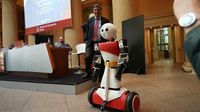In a landmark development for tourism and public service, a robot named Adriano will commence its role as a tourist guide at the Temple of Hadrian in Piazza di Pietra, Rome, starting on March 24, 2025. The robot, named after one of ancient Rome's most renowned emperors, is the first fully automated tourist guide employed by the Italian public administration and marks a blend of technology with historical engagement.
Adriano has been programmed to converse in both Italian and English, providing visitors with detailed information about the Temple of Hadrian and the rich history of Rome. Its advanced robotic capabilities extend beyond verbal communication; Adriano can shake hands with guests, adding a personal touch to its interactions, and it can manipulate physical objects while ensuring a high level of safety throughout all exchanges.
Developed through a collaborative effort of four leading Italian institutions—the Istituto Italiano di Tecnologia, Sapienza University, Babelscape, and the SoftBots Laboratory of the University of Pisa—this innovative project was brought to life by a team of over 30 engineers and researchers. The development process spanned 18 months and represented an investment of 137,000 euros.
Lorenzo Tagliavanti, President of the Chamber of Commerce, commented on the project, emphasizing its experimental nature and its potential to showcase how robotics can intersect with artificial intelligence. He stated, "Adriano is a pioneering experimental project that we have vigorously promoted to help understand how interconnections between robotics and artificial intelligence can lead to the creation of tools that can improve the quality of life for individuals. Adriano finds its place in a unique architectural context in the heart of Rome, where history and innovation dynamically and successfully merge."
Giorgio Metta, Scientific Director at IIT, elaborated on the importance of this initiative, saying, "It is a first step towards a future where machines interact naturally with people, supporting and enhancing the services available to the public." Such interactions seem crucial in a world where technology increasingly integrates into daily life.
The creation of Adriano is not only innovative but also indicates Italy's commitment to pioneering projects with significant technological advancements. Antonio Bicchi, head of the SoftBots Laboratory, noted, "This is the first time in Italy that the public administration has led a project of such innovative scope," signaling a shift in how public services can utilize technology to engage with citizens.
Furthermore, Daniele Nardi from Sapienza University, mentioned, "Adriano has capabilities that allow it to be autonomous and expressive in vocal interactions," hinting at the robot's ability to adapt its communication style to better connect with individuals, thus enhancing the tourist experience.
As the world moves towards greater integration of robotics in various sectors, Adriano stands as a symbol of modern advancements in artificial intelligence and robotics, representing what future interactions may look like in a creatively merging realm of ancient history and modern technology. Visitors to the Temple of Hadrian will not only be able to explore ancient relics of Rome but will experience firsthand the cutting edge of technological innovation, making for a uniquely enriched visit.
The introduction of Adriano could change the landscape of how tourism is experienced in cities steeped in history, where the past is now bridged by the capabilities of the future. As Adriano settles into its role, it will be fascinating to observe how effectively this robotic guide engages with visitors and enriches their experience in one of the world's most historically significant locations.

